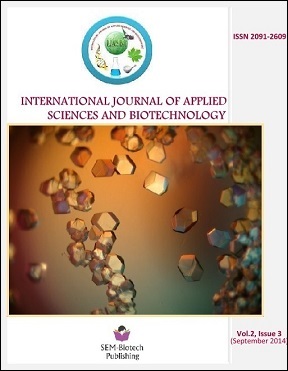Weeds and Their Effect on the Performance of Maize and Finger Millet in Mid-Hills of Nepal
DOI:
https://doi.org/10.3126/ijasbt.v2i3.10790Keywords:
maize/finger-millet, hills, weeds, index, grain yield,Abstract
Relay cropping of maize with fingermillet (maize/fingermillet) is the predominant cropping system for sustaining food security situation in the hilly regions of Nepal. In this region weed pressure severely reduces crop yields. Basic information on weed species composition, biomass production and their effect on crop yields and economics are lacking for this region. This information will be necessary to develop effective weed management strategies for the future. In light of this an empirical study was carried out in two representatives mid hill districts of Parbat and Baglung during summer season of 2010/2011 in Nepal. A total of 10 major weed species with densities of 172 in Parbat and 311 per 0.25m2 area in Baglung were observed. The highest percentage of both relative and absolute densities were recorded for Ageratum conyzoides in Parbat and Polygonum chinensis in Baglung. Weed infestation under farmers practice of crop management reduced the grain yield of maize by 1.985 Mt ha-1 (117%) in Baglung and 1.760 Mt ha-1 (108%) in Parbat. Similarly, in finger millet it was 0.489 Mt ha-1 (63%) in Baglung and 0.403 Mt ha-1 in Parbat. Similarly, the combined yield of both the crops was also significantly reduced by 79.3% and 61.7% in Baglung and Parbat respectively. Hence, weeds are directly affecting the crop performance in the region. Therefore, there is an urgent need to develop an alternative crop production system in the hills.
DOI: http://dx.doi.org/10.3126/ijasbt.v2i3.10790
Int J Appl Sci Biotechnol, Vol. 2(3): 275-278




